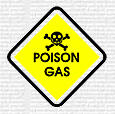Carbon Monoxide
Overview
Carbon Monoxide is an odorless, colorless gas that cannot be detected by the human senses. It becomes deadly by replacing oxygen in the human blood stream. This takes some time and therefore the danger is a function of time, gas concentration level, and the individual. Most CO poisoning takes place during the winter, the same season for most colds and flus that have similar symptoms.
CO Detectors are set to go off between 9 and 35 ppm (parts per million). Levels over 100 ppm in a confined space over a period of time can be lethal.
New furnaces with outside combustion air are not likely sources of CO. CO is generally not created in a deadly concentration. Rather, it tends to builds up over time as air already contaminated with CO and thus also having less O2 (oxygen) gets recirculated back through the combustion process, producing more and more CO with each pass through the combustion process. When spaces are confined and there is little to no new oxygen coming into the space, CO builds to a toxic level. This is what makes unvented space heaters so dangerous – especially the older ones that do not have O2 depletion sensors to automatically shut them off if O2 levels drop to a dangerous level (if they work as designed).
Sources of Carbon Monoxide
- Unvented kerosene and gas space heaters
- leaking chimneys and furnaces
- back-drafting from furnaces, gas water heaters, wood stoves, and fireplaces
- gas stoves
- Automobile exhaust from attached garages (note: autos with catalytic convertors produce almost no CO under normal running conditions)
- Environmental tobacco smoke
Health Effects Associated with Carbon Monoxide
At low concentrations, fatigue in healthy people and chest pain in people with heart disease. At higher concentrations, impaired vision and coordination; headaches; dizziness; confusion; nausea. Can cause flu-like symptoms that clear up after leaving home. Fatal at very high concentrations.
Levels in Homes
Average levels in homes without gas stoves vary from 0.5 to 5 parts per million (ppm). Levels near properly adjusted gas stoves are often 5 to 15 ppm and those near poorly adjusted stoves may be 30 ppm or higher.
Steps to Reduce Exposure to Carbon Monoxide
- Keep gas appliances properly adjusted.
- Consider purchasing a vented space heater when replacing an unvented one.
- Use proper fuel in kerosene space heaters.
- Install and use an exhaust fan vented to outdoors over gas stoves.
- Open flues when fireplaces are in use.
- Choose properly sized wood stoves that are certified to meet EPA emission standards. Make certain that doors on all wood stoves fit tightly.
- Have a trained professional inspect, clean, and tune-up central heating system (furnaces, flues, and chimneys) annually. Repair any leaks promptly.
- Do not idle the car inside garage.
For More Information
Go to the US EPA web site at www.epa.gov/iaq/co.html
